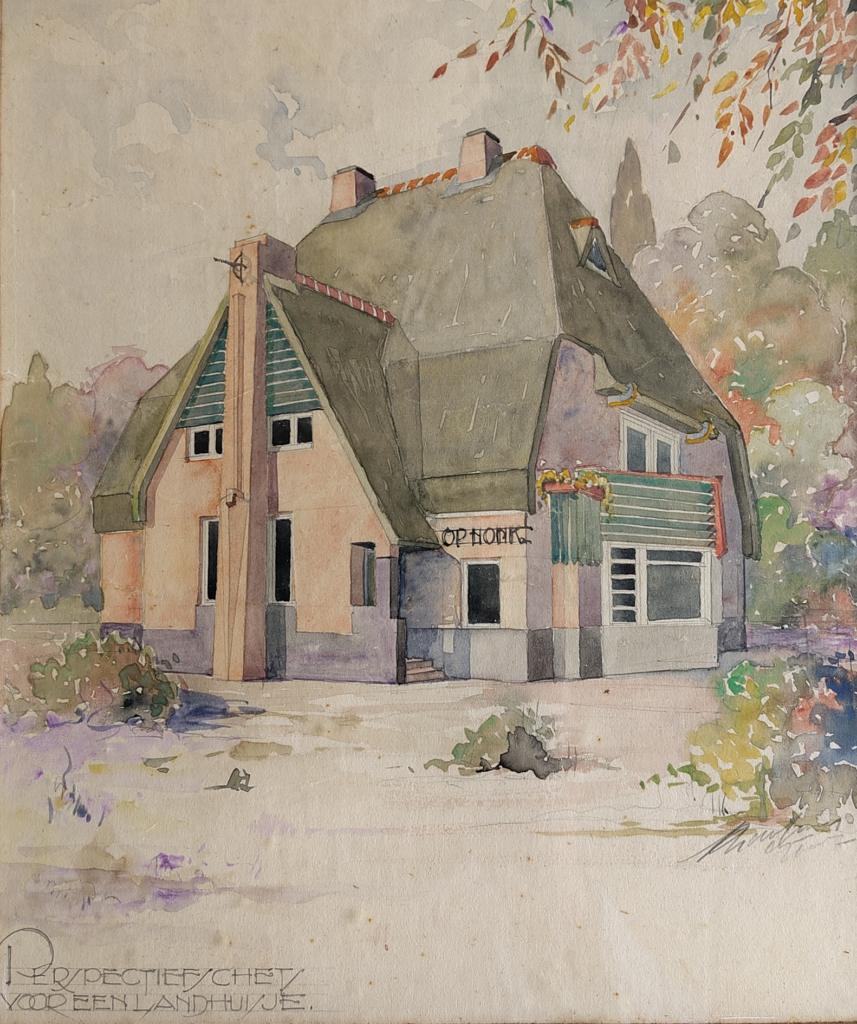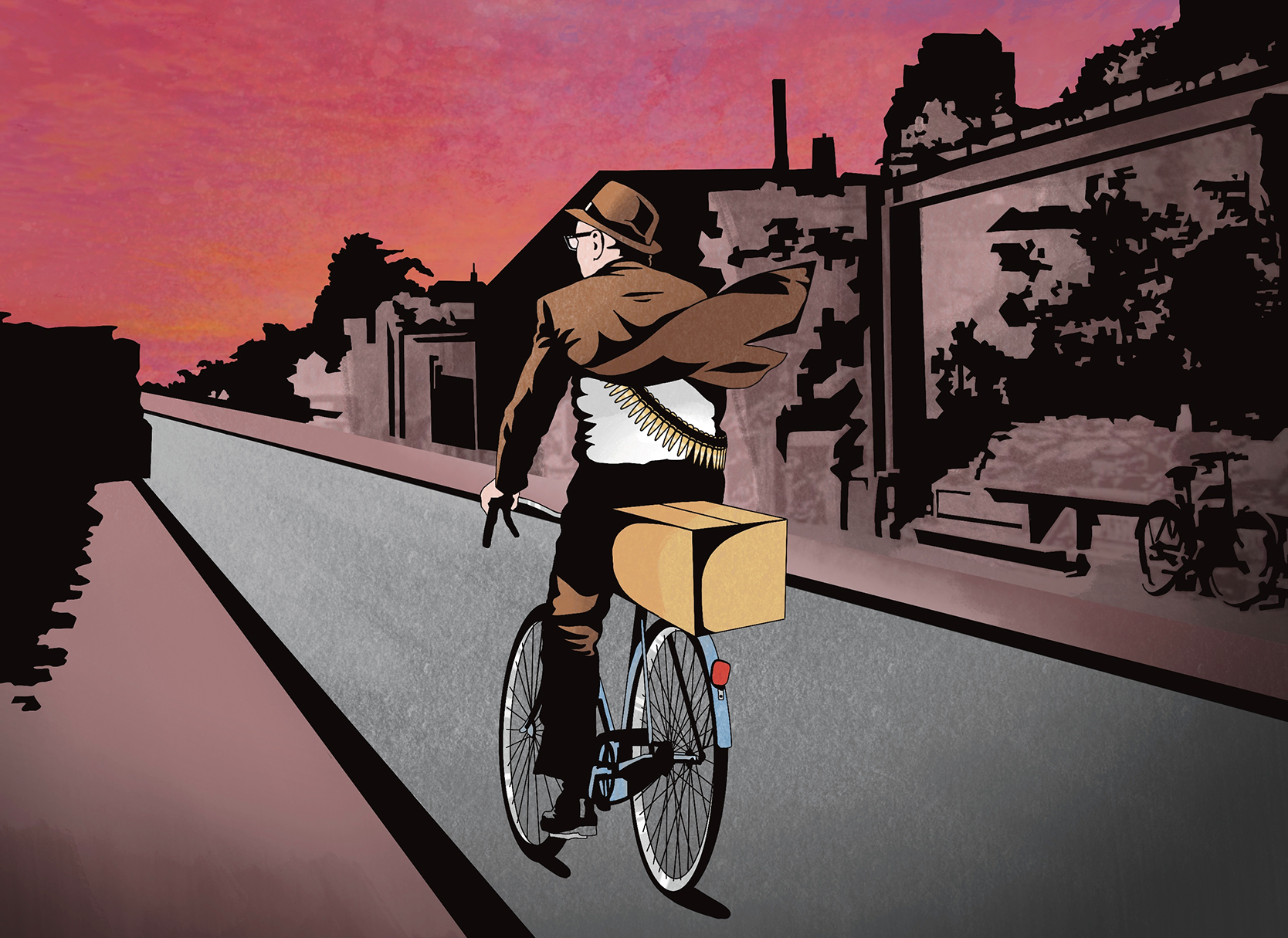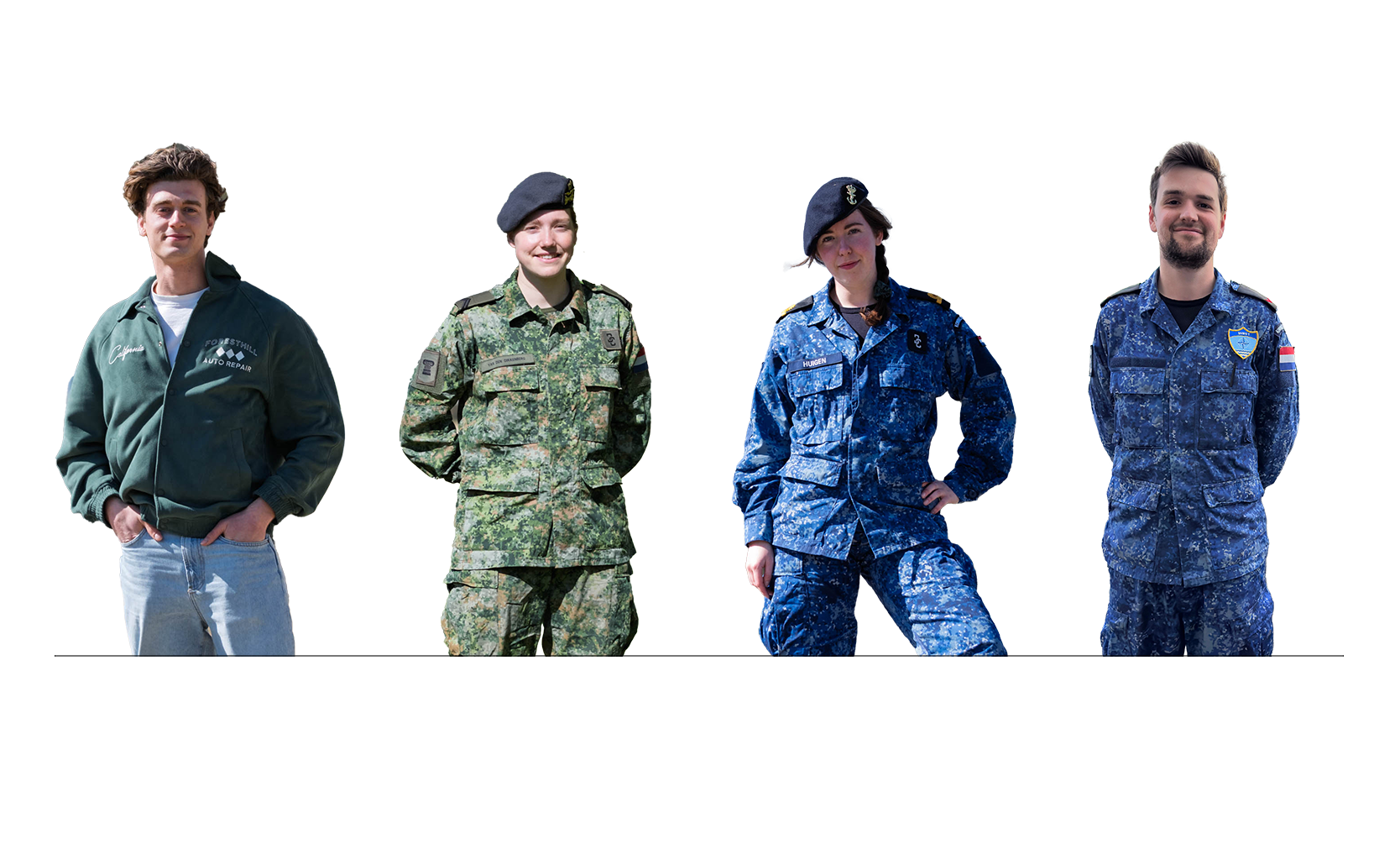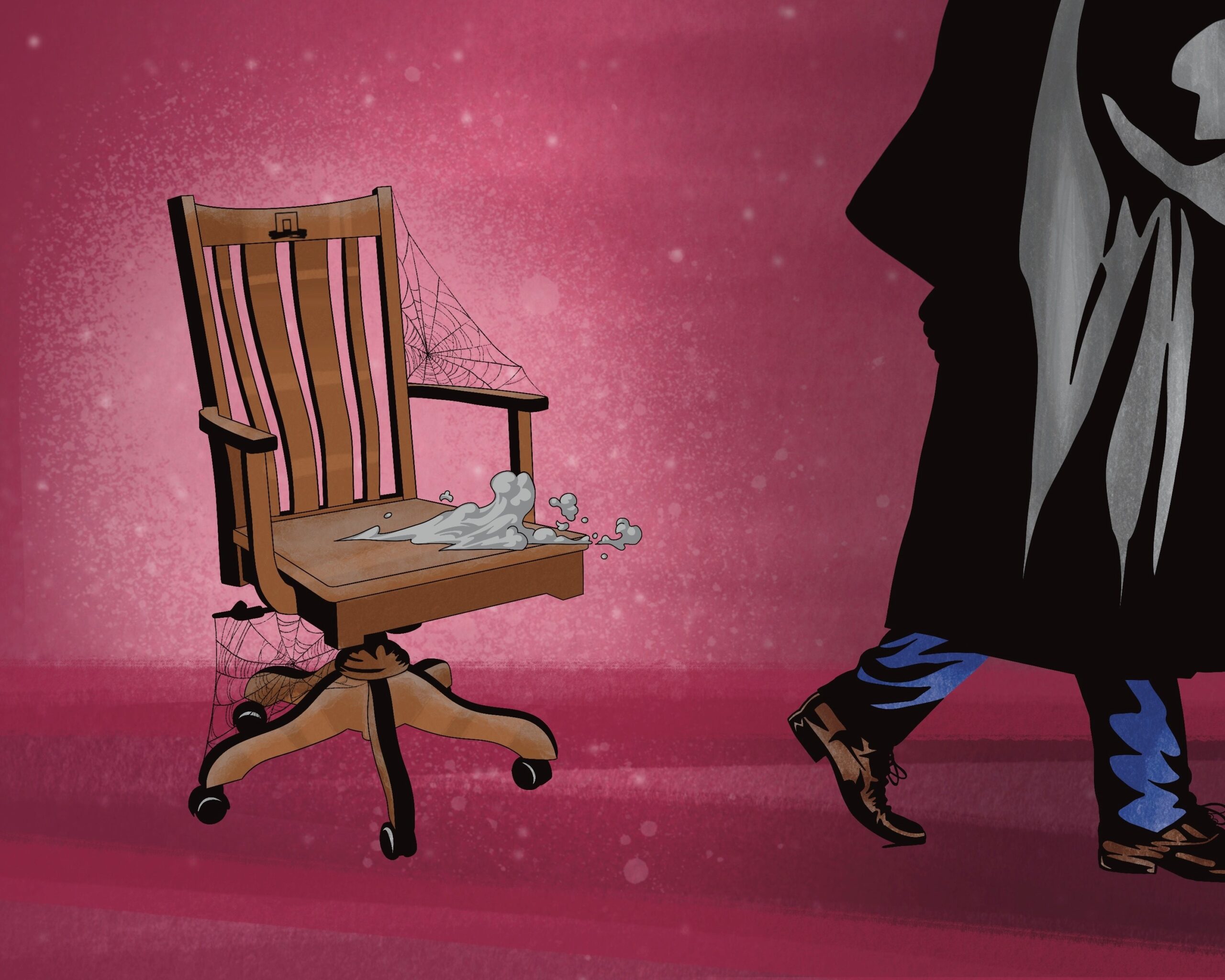Chemistry professor Simon Olivier should have his name printed in gold in the WUR history books. His efforts resisting the Nazis — the Netherlands is celebrating 80 years of liberation from the
Germans this year — is a shining example to us all.
It is half-past one on a Sunday afternoon, on a dark autumn day in 1940. The teacher Frans van der Have gets a knock at the door. He finds Olivier standing there, wearing a sturdy overcoat. There is a large package attached to the rack on his bicycle. It contains parts for a light machine gun. These details come from the book the teacher wrote after the war about the Resistance in Wageningen, Kleine Kroniek van het verzet in Wageningen over de periode 1940-1945.
I want nothing to do with that Hitler rubbish. They may be behaving OK as yet, but you keep an eye on them
‘When he takes off his coat, it reveals a cartridge belt hanging round his neck. He got hold of all of this in Veenendaal and cycled back to Wageningen across the Binnenveld with his cargo.’
‘Olivier’ is Simon Olivier, professor of Organic Chemistry at Wageningen Agricultural University. At this point in 1940, the Netherlands had been occupied for nearly six months by Nazi Germany. The Resistance in Wageningen was slowly starting to take shape, writes Van der Have in his book. He himself grew to become a leader of the Resistance during the war. He soon found a like-minded spirit in Simon Olivier. Van der Have recalled their first meeting. Olivier said, ‘I’m an old social democrat and I want nothing to do with that Hitler rubbish. They may be behaving reasonably OK as yet, but you keep an eye on them.’
Inner anguish
‘Old’ was not just a reference to his lengthy association with the social democrats; Olivier was already 61 when the war broke out. The man with the cartridge belt around his neck was no youngster in search of adventure. His resistance was out of principle. ‘His rejection of any form of oppression or restriction in the freedom of the mind caused him inner anguish when faced with the rise of Nazism and Fascism, whereby he found support with others who, like him, fought the emerging threat from an early stage,’ wrote his fellow chemist Henri Tendeloo in the chemistry journal Chemisch Weekblad in 1949 on Olivier’s retirement as a professor.
Olivier found the naivety of the intelligentsia during the pre-war years ‘often astonishing’
In the years before the war, Olivier was a member of the Neutral Countries Committee, the Free Spain Committee and Aid to Spain. At the invitation of Spain’s Republican government, he visited the country in 1937 to see the Spanish Civil War at first hand. In that same year, he joined the Vigilance Committee of Anti-National-Socialist Intellectuals, founded in 1936 with the aim of warning the Dutch about the dangers of Nazism. The committee members included such prominent individuals as the historian Jan Romein and the author Menno ter Braak.
Simon Cornelis Johannes Olivier was born in Amsterdam in 1879. He was the oldest of three sons. He lived in Amsterdam until the age of ten, long enough to keep the typical Amsterdam sense of humour for the rest of his life, according to Tendeloo. After the early death of his father, the family moved to Apeldoorn, where Olivier went to secondary school. In 1901, he graduated as a chemical engineer in Delft. He worked briefly at the agricultural research station in Groningen before becoming a physics and chemistry teacher in Nijmegen. In early 1905, he moved to Wageningen to become a lecturer at what was then the National Higher College of Agriculture, Horticulture and Forestry. In 1918, when the Agricultural University was founded, he was appointed professor of chemistry. Apart from a short break during the war, he continued in that post until he retired in 1949.
Outsider
Simon Olivier was politically engaged and outspoken, which made him something of an outsider. According to him, the Dutch intelligentsia were not much interested in politics or public life during the pre-war years. And ‘their naivety was often astonishing’. He made these comments during his speech on the reopening of the Agricultural University in September 1945. A couple of weeks after the liberation of the Netherlands in May, the Military Authority of Gelderland had appointed him rector magnificus. In the speech, he gave an apt example of that naivety when he recalled a ‘scientific man’ saying — presumably in 1935 — ‘that if Einstein had been treated so badly in Germany, he must have brought it upon himself’. Olivier’s evident alertness to what was going on before the war turned into active resistance during the occupation. It was simply not in his nature to watch from the sidelines. Resistance fighter Van der Have gives some nice examples of Olivier’s resistance activities. For example, Olivier turned up one day with a recipe for protecting woollen fabrics against moths. ‘Could the recipe be sent to England as soon as possible, because they are losing a fortune from moths destroying woollen blankets and uniforms.’ Later, he did experiments with poison that he smeared onto arrow heads as a proof of concept, using the arrows to shoot rats in the canal behind the university’s main building. The poison was deadly. ‘If they want, I can give it to them to dip bullets in,’ he told Van der Have.
Olivier signed the Aryan certificate after being threatened with dismissal. ‘Quite wrong,’ he said later
Then there was that time he had an employee deliver a cardboard box. ‘The professor has had these glass spheres made; they are filled with a dangerous explosive,’ explained the assistant. ‘I came on foot because it’s important not to shake them. Look, they’ve been packed neatly in wood shavings. Be careful because otherwise the whole thing will blow up.’

Aryan certificate
It was not long before Olivier clashed with the Nazi authorities. When employees of the Agricultural University were ordered to sign an Aryan certificate in October 1940, he refused initially. He signed eventually, but only after he was threatened with dismissal. ‘Completely wrong,’ he said himself after the war. When this was followed by the first dismissals of Jewish employees, student strikes broke out. Some professors stopped teaching for a few days in protest. Others, including Olivier, used their lessons to draw attention to this injustice. In Olivier’s case, this resulted in him being hauled up for a hearing in January 1941 at the Ministry of Education in The Hague. He was let off with a final warning. Six months later, in July, he was not so lucky. Student supporters of the Dutch Nazi party (NSB) covered the windows of the main university building with posters showing the German V for Victory sign. Olivier had the posters removed immediately. A few days later, he was arrested. He was held in captivity for 11 months, including in the notorious Oranjehotel in Scheveningen and the Amersfoort concentration camp. In his own words, this was where he ‘got to know close-up the methods used by the Germans to make their opponents see reason’. This was also where he met his former assistant Gèza Berger, who had been dismissed in 1940 because he was Jewish. Olivier and Berger had worked together for years. This would be the last time they saw one another.
Forty Wageningen residents were killed, including Simon Olivier’s wife and only son
Berger was deported to Germany, never to return. Olivier was released in summer 1943. He was aged 64 by then and was very weak. He was no longer a professor, and he was banned from publishing and from entering university towns. He retired to the Betuwe to recuperate. Then he left for The Hague, where he started work again in a laboratory. That was where he experienced the greatest blow the war brought him.
Bombardment
It was Sunday morning, 17 September 1944, a fine autumn day with mist hanging in the trees and a clear blue sky. Planes could be seen ahead, as the Battle of Arnhem was about to start. Then all hell broke loose. No fewer than 160 fragmentation bombs were dropped on the recently-built Sahara district on the slopes of Wageningse Berg. By mistake. The Allied bombs were intended for the German anti-aircraft guns half a kilometre away near the Lexkes ferry. Forty Wageningen residents were killed, including Simon Olivier’s wife and his only son. They died in the front garden of their home on Bergstraat.
One year later, Olivier recalled this event in his speech during the reopening of the university, with remarkable restraint. ‘The oppression and terror was followed by the violence of war with all its horrors. The parachute landings near Oosterbeek were preceded by an aerial bombardment that hit and almost completely destroyed the laboratory for agricultural chemistry.’ Not a word on his own huge loss.
Op Honk
Simon Olivier lived in the Sahara district on Wageningse Berg from 1925 to his death in 1961. He had the impressive house built himself in the Amsterdam Style. The house, now exactly 100 years old, is a municipal listed building these days. The current occupant, Anneke Blokhuis (88), bought it in 1981 from Olivier’s widow (he remarried shortly after the war). The house is largely the same as it was in Olivier’s day. It miraculously survived the erroneous bombing in 1944. An aerial photograph from that period shows that the neighbouring houses were reduced to bomb craters. The only signs of the bombing in Olivier’s house are some repairs in the walls after damage from grenade fragments. The only reminder it contains of Olivier is a watercolour of the house. ‘Shortly after we moved here, a woman brought us this,’ recalls Anneke Blokhuis. ‘She used to come here a lot as a child. I don’t know her name or how she came by this painting.’ The house is called Op Honk in the painting, but it never had that name in real life. The name ‘Olivier’ lives on in the Sahara district in the street called Olivierlaan just a stone’s throw from his former home.
A life full of adversity
Simon Olivier experienced a lot of adversity in his private life. The biggest blow was undoubtedly the bombing in 1944 that killed his wife Maria Haitsma and his 19-year-old son Tim. His daughter Jeanne was already married by then and no longer living at home. The names of Maria and Tim are recorded on the monument in Ericaplein that was put up in 2019 to remember the bombing.
Simon and Maria married in 1913 when he was 34 and she was only 23. His first marriage, to Gesina Smit from Wageningen, had ended three years before. He had married her one year after being appointed a lecturer in Wageningen at the age of 25. This marriage produced a daughter, but she died when only one week old. After the bombardment in 1944, Olivier got married for a third time. His third wife was Ida Luyten, the chief assistant in the Laboratory for Plant Physiology. He was 65, his new wife in her early fifties.
Olivier’s daughter Jeanne had an intellectually disabled daughter from her first marriage, which ended in 1945. She married again later on in life and her step-son-in-law Michiel Moerdijk has warm memories of her. ‘She was an important civil servant in the Ministry of Agriculture. A strong, amazing woman. Very modest. But she never talked about her father. She also never said her brother had died in that bombardment.’ Jeanne died in 1990.
Despite all this, the name Olivier lives on, as Moerdijk gave one of his children that name. The Royal Netherlands Chemical Society recently established the Olivier lectures. The first two were held last month during the biennial conference in Lunteren.

 Illustration Valerie Geelen
Illustration Valerie Geelen 

